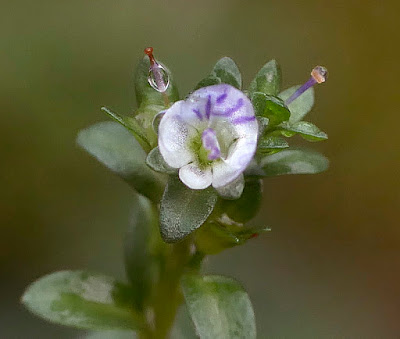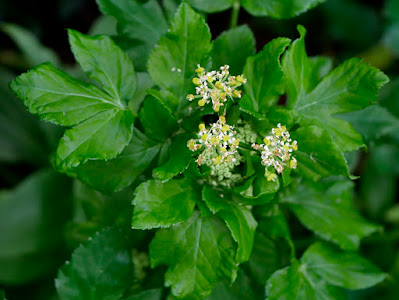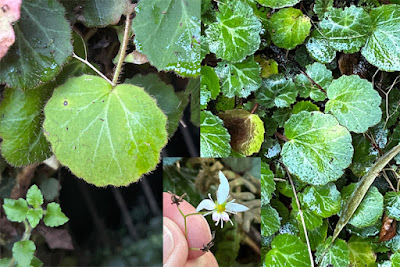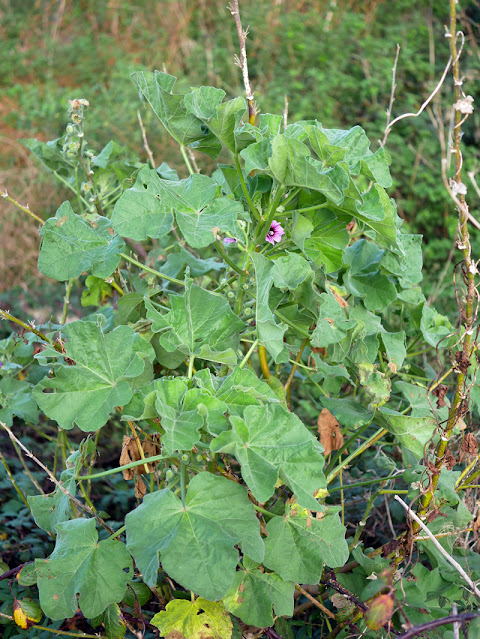As the year draws to a close, the colder weather takes its toll on many plant species, so there is less to see than in the summer, which we all know already. But it's good to get out and about and there are always surprises, whatever the time of year. I am writing this at the end of December and we have had a few light frosts, hurricane gust storms, flooding, weeks of grey, still, misty weather with no sunshine and even a bit of snow in this period. However, the plants soldier on and the following are some of those plants I found on my recording trips at this time.
Heather is a late summer flowering plant, but early November is the latest I have ever seen it still flowering. I found this on a trip to the china clay country, which is pretty barren for plant diversity due to a lack of nutrients and stability in the soils left after mining.
Calluna vulgaris
Some Sheep's-bit hanging on into the winter.
Jasione montana
The china clay waste sites are a haven for mosses and lichens, a subject I haven't really delved into yet, but I couldn't resist taking a photo of some "Soldier" lichens, there were thousands of them.
Lunch at a Bodmin Moor pub yielded a Bacopa flowering in the tarmac of the car park. No doubt an escape from a nearby garden as there were no hanging baskets nearby. Car parks are often great places to find interesting plants; this same car park had most species of Willowherb in it in the summer, including the unusual New Zealand Willowherb.
Chaenostoma cordatum
A very late flowering Field Forget-me-not in the same pub car park.
Myosotis arvensis
A trip to a north Cornwall woodland revealed many hundreds of Marsh Ragwort. This species is found throughout much of the UK (excluding parts of the south east), but is is declining so much, it has been listed as Near Threatened. It likes damp or wet woodland rides and heaths in Cornwall. Note the very large terminal lobe on the leaves which other ragworts don't have. The flowers are also almost twice the diameter of common ragwort too.
Jacobaea aquatica
I sometimes photograph insects, provided I don't have to chase them around (like butterflies!). Given this was mid November, this beetle was rather torpid, clasping a Soft Rush stem. I was told online that is a Bronze Beetle.
Chrysolina banksi
Lesser Celandine leaves (and some flowers) are beginning to appear now, these are usually pretty much plain green, with perhaps some splodges on them of a different shade of green. Each year, I usually find some stunning looking variegated leaves, such as the one below that I found at Millendreath, near Looe. I had only heard of "Brazen Hussy" a purple leaved form grown in gardens and wondered why other varieites weren't listed on the BSBI database. So I dug deeper and reliable contacts informed me that all the Lesser Celandine variants grown in gardens are actually taken from the wild. They all occur as natural variations of Lesser Celandine. Of course, gardeners seek these out and cultivate them, but nature has already done all the work. I was given a link to some very interesting variants, so take a look at them and see if you can spot any this coming Spring.
http://www.johnjearrard.co.uk/plants/ficariaverna/genus.html
That link will take you to (mostly) all of the forms of Lesser Celandine currently recognised in the garden trade. Go to the home page and there are hundreds of plant species you can look at, a very good resource to bookmark. Anyway, the leaves below seem to fit the variant named "Brambling".
Ficaria verna "Brambling"
Mid month I took a trip to the Roseland Peninsular, around St. Just-in-Roseland, a picturesque place with an amazing flora too. Habitats ranged from churchyards with sub tropical plants to woodland, to salt marsh, rural lanes and wasteground. The more habitats you have, the more species you will find.
The following photos are some of the plants I found here, growing wild or naturalised.
Thale Cress nowadays, is usually found in urban areas, like pavements and wasteground, so it was nice to find several hundred of them in an arable field.
Arabidopsis thaliana
Also in the fields were Lesser Quaking Grass, which I'm finding more of in Cornwall recently. It grows much taller than Quaking Grass (
Briza media) and its florets are all shades of green with no purple parts that the other two Briza species have. The stems are sturdy, but the stems holding the florets are flimsy, hence they "quake" in the slightest breeze.
Briza minor
A stunning colour variant of Wild Radish, probably a crop relict previously sown as a cover crop.
Raphanus raphanistrum
Field Woundwort rounds off the arable fields, quite common in parts of Cornwall, but rare in other places. This species is also near threatened in England due to modern methods of agriculture.
Stachys arvensis
On some waste ground, I found a late flowering Black Nightshade. These are in the same family as potatoes and tomatoes; in fact, the flower is almost the same as that of a potato, but much smaller. Don't eat this plant or its berries though (which start off green then turn black) as they are mildly poisonous. A quote from https://www.wildfooduk.com/wild-plants/black-nightshade/ : "Ingestion causes effects delayed by 6 – 12 hours including vomiting, diarrhea, sweating, confusion, and abdominal pains." Personally, I don't eat any wild plants (other than the occasional blackberry).
Solanum nigrum
I had only seen Krauss' (or South African) Clubmoss as a weed in Heligan Gardens before. Although it was never planted there as it was introduced accidentally, being in a garden rather devalued the record somewhat. However, I found lots of it in St. Just-in-Roseland churchyard and a whole roadside bank covered in it nearby, the latter truly an escape into the wild.
The BSBI plant atlas 2020 at https://plantatlas2020.org/atlas/2cd4p9h.4kf shows a smattering of records across the UK. There are 908 records in total with the majority recorded after 2000, so it's spreading rapidly.
Selaginella kraussiana
In a couple of places, in woodland and a rural by-way, I found Yellow-flowered Strawberries. The atlas at https://plantatlas2020.org/atlas/2cd4p9h.7q6xct shows a distinctly southern distribution.
The atlas describes it thus "P. indica has been in cultivation in
Britain since 1805, and grown in gardens for its yellow flowers and
strawberry-like, but inedible, fruits. It was recorded from the wild by
1879 (Trengwainton, West Cornwall) and is clearly increasing, notably in
south-eastern England and East Anglia, including Fenland. It may have
been partly overlooked in the past in mown swards, since in leaf it can
easily be passed over for Fragaria vesca" (Wild Strawberry). Credit to D.J. McCosh and J.O. Mountford for this description.
Potentilla indica
In the churchyard, I found an unfamiliar species running rampant in neglected areas, spreading by stolons under the surface. A plant ID app got me to Creeping Saxifrage, later confirmed as this species. It's now fully naturalised here. Here's a composite photo showing the leaves and small flowers.
Saxifraga stolonifera
Another unusual plant to be flowering this late in the year was a Tree Mallow, which usually flowers from spring through summer.
Malva arborea
Of course, one of stalwarts for providing lots of sweet almond smelling flowers in the winter is the Winter Heliotrope, widely naturalised throughout England and beyond.
Petasites pyrenaicus
For much of December, I didn't go out, due to poor health and bad weather. However, when I did get back, just before Christmas, I found some Round-leaved Water Crowfoot growing in tractor ruts on a china clay waste site. It will probably be flowering by February.
Ranunculus omiophyllus
Velvet Shank fungi looking great on a tree trunk.
This brings us to Christmas Eve, when I found I had a couple of hours of spare time, so I had a look around a small village near Rock to see what I could find. I recorded lots of species, but it was great to find Stinking Hellebore growing in a cornish hedge; only the second record for this that I've found here, they aren't native to Cornwall and are considered a neophyte. This one probably originated from fly tipped material.
Helleborus foetidus
Some Leylandii saplings on wasteground had me baffled for a while, but the nearby parent trees showed them to be Montery Cypress, self sown and growing well.
Hesperocyparis macrocarpa
An industrial estate tarmac road edge was the unlikely habitat for Corn Parsley, though I did also find it nearby in a field where it should be!
Sison segetum
That wraps up my winter finds of 2024 up to 28th December. My next blog will include my efforts on the BSBI's new year plant hunt, a project to find as many wild or naturalised species in flower as possible over the new year period. If you're reading this in time, see https://bsbi.org/ for full details and how to participate. Until then, happy plant hunting and a healthy, prosperous new year to you.
Dave





















































































